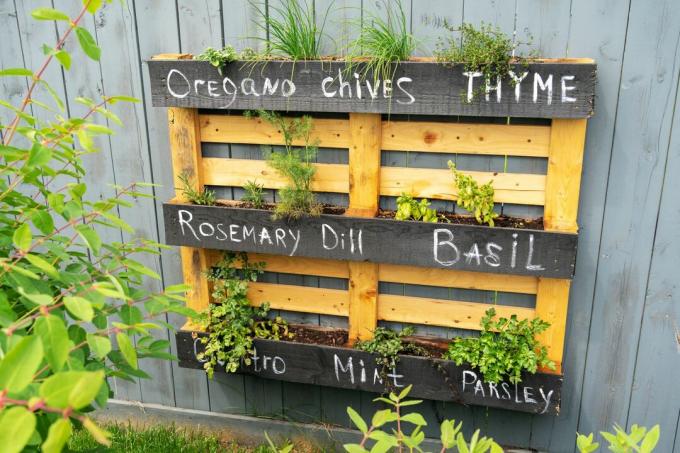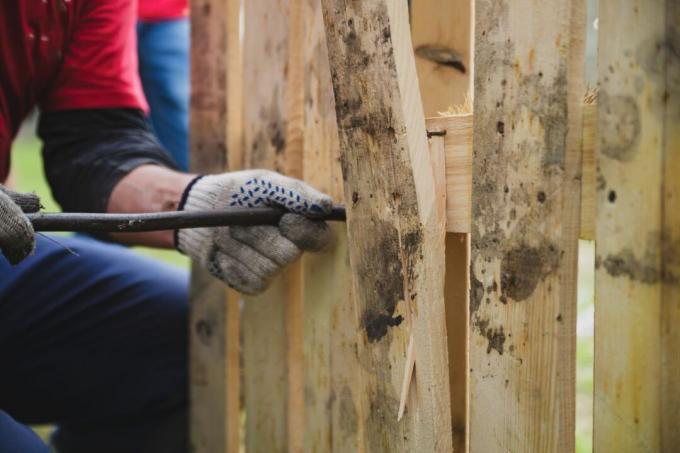A herb bed made from pallets can be placed on any balcony, no matter how small: a Euro pallet can be turned into a herb garden in just a few simple steps.

Not only seating furniture for the balcony can be built from old pallets: it is much easier to build a space-saving herb bed from a pallet. You can find instructions on how to build your own herb rack and tips on planting correctly here.
contents
- Herb wall made of pallets: what are the options?
-
Build your own herb rack from pallets
- Instructions for a herbal palette
- Plant the herb pallet correctly
Herb wall made of pallets: what are the options?
For all balcony gardeners, a herb bed made from pallets is the ideal way to have seasonal, fresh herbs available at all times without taking up a lot of space. The narrow bed fits on every balcony and also offers an opportunity to give old materials new life. Placed in the right place, it also fulfills the function of a privacy screen. But the herb palette is not only practical: it can also be a great decorative element to beautify a balcony wall. Attached to it with a chain of lights, the herb rack from a palette creates a cozy atmosphere in the evenings too.
But you can also place the pallet herb bed in the garden. It is wonderful as a partition between two beds to create some structure. The range of herbs is also good as a visually appealing demarcation of a seating area or another garden area. Or you hide your rubbish bins behind two pallet herb beds placed one on top of the other. So there are many possibilities for a herb bed made of pallets.

Build your own herb rack from pallets
Building a herbal palette yourself is very easy. Depending on how much fun you have with tinkering and how much time you have, there are different ways to make the herb rack yourself from pallets. Below we present a few options.
Instructions for a herbal palette
Materials:
- A Euro or other pallet
- sander and paper
- Thick plastic wrap (e.g. B. thick garbage bag or pond liner)
- Wooden tacker or nails and hammer
- wood screws and drill driver
- Possibly thin wooden boards in the width of the plant boxes
- Optional: hammer with claw, pry bar/crowbar or crowbar
- Optional: blackboard paint or foil and chalk
Building instructions in 6 easy steps for the pallet herb rack:
- Optionally remove the second and fourth board of the euro pallet with the crowbar or a similar tool. In this way, the herbs later get light from two sides, but the privacy protection function is then less given.

- Sand down the boards of the pallet with the sander to avoid someone getting splinters into their skin later.
- The boards removed or purchased serve as a floor for the plant boxes of the herb shelf. Nail or screw these to the pallet's crossbars from below, creating a small box. If you want it to be very precise, saw out small recesses for the feet of the pallet. Otherwise there is a small gap, which is not a big deal.
- Drill a row of holes in the center of the bottom of the resulting planter to avoid waterlogging.
- Cut the film to size and line the planter with it. To do this, use a wooden tacker or nails and a hammer. This is important so that the wood does not rot so quickly due to the moisture. Some larger holes should also be pierced in the foil above the wooden holes.
- Optionally, the front of the planter box can be painted with blackboard paint or covered with blackboard film. This allows the herb palette to be labeled. Alternatively, you can simply use plant signs that are stuck into the ground.
Just set it up and the pallet herb wall is ready to be filled!

When it has to be fast: In many hardware stores or online there are already ready-made planters that you simply hang in the pallet. In this way, the herb bed from a pallet is ready in less than five minutes.
If you don't feel like screwing: Even without the wooden planter base, the pallet herb bed is stable enough. But then make sure that you use a tear-resistant plastic film. Garden fleece is also suitable.
Plant the herb pallet correctly
Which herbs are suitable for a herbal palette? There is enough space for most of the typical kitchen herbs.
Tip: With some herbs, it is worth reaching for small varieties, such as rosemary and sage - because these develop into large shrubs and become fast in small volumes of substrate unhappy. Other very tall herbs include borage, comfrey, southernwood, and lemon verbena.
The following must be observed when planting the herb palette:
-
The right substrate: Many herbs prefer rather nutrient-poor and loose soil. These include many of the Mediterranean herbs, such as rosemary (Rosmarinus officinalis), thyme (Thymus vulgaris), sage (Salvia officinalis) and spiced lavender (Lavandula latifolia). Our loose Plantura Organic Herb & Seed Soil is ideal for these herbs with its pH value of 6.1 to 6.9.
Others have higher nutritional needs. These include basil (Ocimum basilicum), chives (Allium schoenoprasum), peppermint (mentha × piperita) and parsley (Petroselinum crispum). These should be planted directly with something Organic universal fertilizer be supplied or you mix in some nutrient-rich soil.
- Select herbs according to the light supply: Depending on how sunny the location for the herb bed from pallets is, the herbs should be selected. Our articles will tell you which ones sun herbs, shadow herbs and Herbs for the penumbra there are. In general, however, the following applies: The herbs on the top floor of the herb palette usually get the most sun. So: Herbs that are thirsty for light should be planted at the top, those that can sometimes tolerate shade should be planted on the lower floor.
- Leave enough space: The soil volume of the pallet herb bed is limited: so do not sow and plant too many herbs in one planter. You should find out beforehand how big the herbs will be and what the recommended spacing is. Potted herbs from the supermarket are shared, so that a planter box with the plants from one Supermarket pot is planted - because the plants are always too close together, which diseases favored.
- Choosing the right neighbors: Some herbs get along well with each other, others can affect each other negatively. You can take advantage of this by planting matching herbs in a planter. In a large table we have summarized here, which herbs go well together.

- Note the water requirements of different herbs: When planting the herb palette, pay attention to the water requirements of the herbs. Those with similar water needs should be placed in a planter. The lower boxes probably always get the dripping water from the boxes above through the holes in the bottom of the boxes. Herbs that tolerate a little more moisture are best planted on the lower floors. Clay balls or a layer of pebbles on the bottom of the planters help to prevent backwater.
- The right time to plant: The Mediterranean herbs in particular like it warm and should therefore only be planted after the end of the frost period. When sowing herbs, you should pay attention to the information on the seed packet.
Tip: Not only the water, but also the nutrient requirements of herbal plants differ. Hungry herbs such as parsley, chives and basil only grow splendidly with regular fertilization. Use a predominantly organic complete fertilizer like ours twice a year for these Plantura organic universal fertilizer, which is particularly environmentally friendly due to the use of animal-free raw materials from the food and luxury food industry. Herbs such as thyme, rosemary and lavender, on the other hand, rarely require additional nutrients. However, at some point they also used up the supply of potting soil.
Now nothing stands in the way of your own pallet herb wall! Another way to grow herbs on the balcony is a raised herb bed. Learn how in our article Create a raised bed for herbs and plant them properly.
